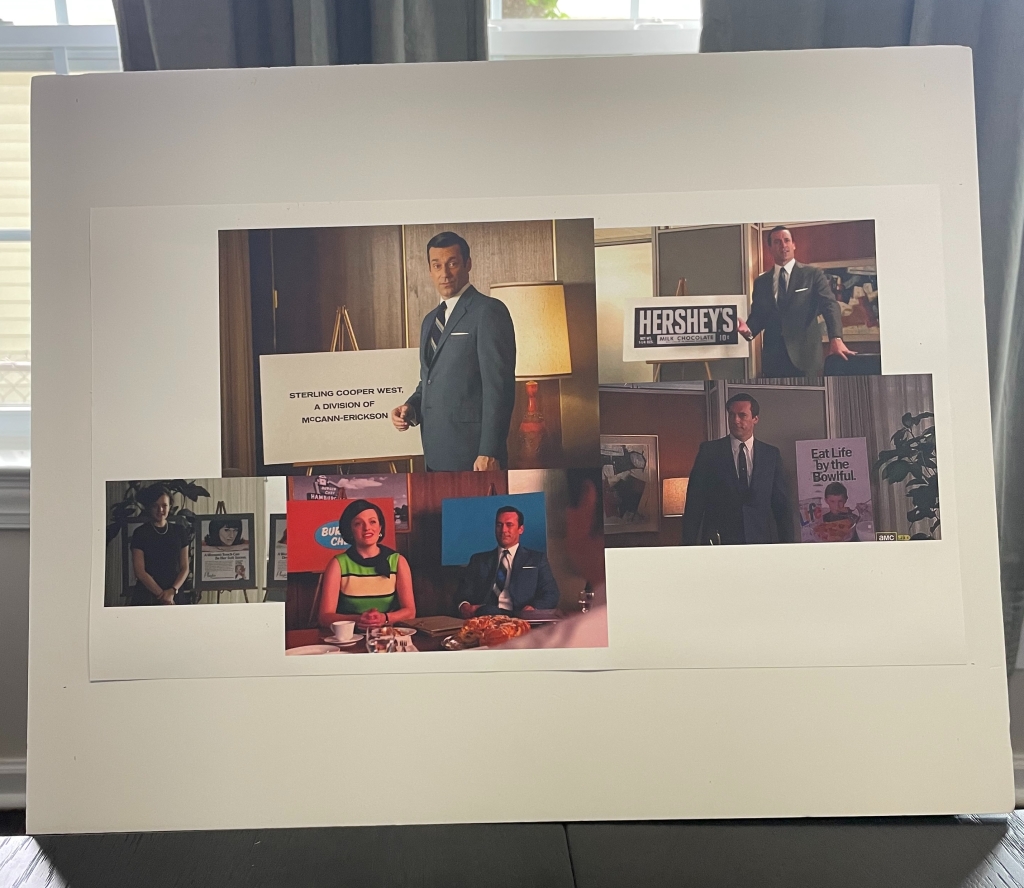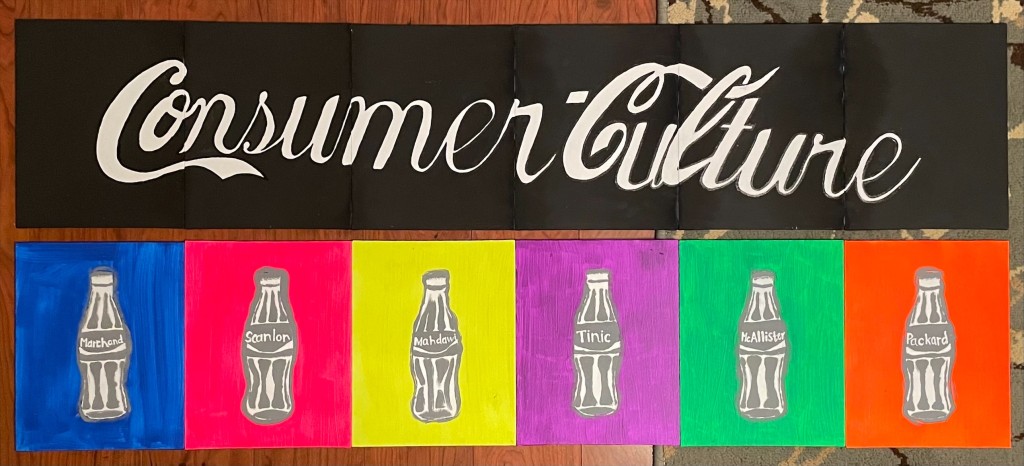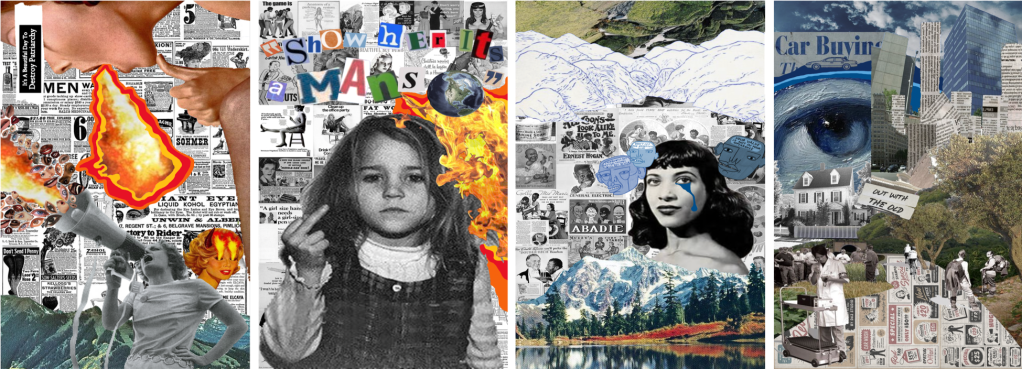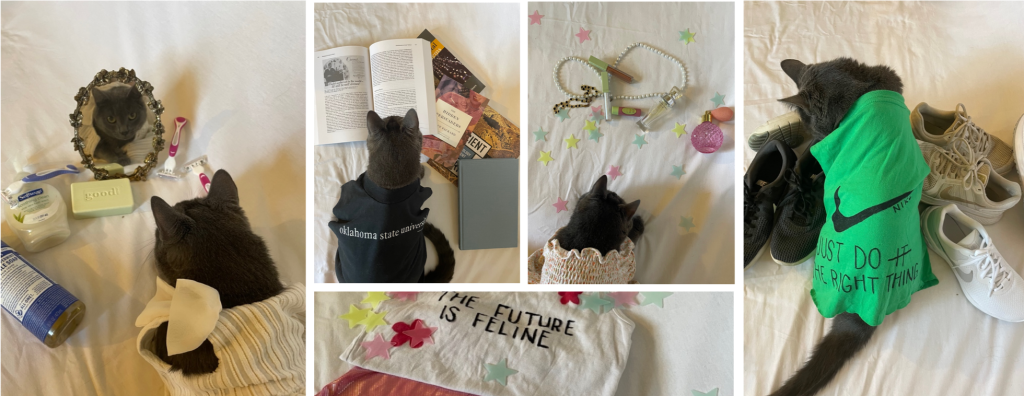This semester in Advertising History, Culture & Critique at the University of Tulsa, I assigned unessays for the second time. Just like the first round, students designed fantastic projects, communicating what they’d learned in creative, fun, engaging—but still critical and intellectually deep—ways!
The full assignment instructions, scaffolding, and rubric are all at the end of the post, but generally, students selected a creative unessay format of their choice to communicate and synthesize everything they had learned in the course, drawing from our three main sections: 1) advertising’s history, 2) advertising’s sociocultural influence when it comes to power and identity, and 3) the advertising industry’s contemporary condition.
A few students were inspired to capture how advertising has changed over time (or not) when it comes to issues of representation, identity, and power. Jayden created a “Then and Now” comparative presentation. Chloris created a timeline collage of ad photo books from 1900 to the present, while Jacob took a similar approach, but starting in 1920 and focusing on a different decade in each letter of the word “advertising.”


During one class day, we viewed the pilot episode of Mad Men and pondered what the series teaches us about the past, present, and future of advertising. Ray’s project represented the entire course’s themes through the show, presenting it in a traditional pitch deck.

Jacob created a spoof on The Twilight Zone, which he called The Advertising Zone. In addition to an opening narration, the three parody ads consider midcentury norms of gender and cleanliness, the contradictions of branding (represented through the “Bland brand” chips), and the tropes of political advertising.
Emily created a movie poster for the course, titling it “Ad Dicted” to critique the addictive aspects of consumer culture. Among the symbols she included, the Gothic mirror on the left represents Roland Marchand’s assessment of advertising as a social mirror that distorts reality, as well as the tactics of modern advertising to inspire and exploit consumer anxieties. The television symbolizes a type of visual cliche of a happy family watching TV together, taking in commercials that offer Disney-like promises of happy-ever-afters, as well as the promise and peril of addressable television, where every consumer receives ads tailored to their data-mined preferences.

Gracie’s project shows how some of advertising’s intentions remain obscured, which she visualized by recreating ads we analyzed in class as billboards where the visuals are made out of words, all passages drawn from our course readings. These images document the role of consumer anxiety in modern advertising, how companies (like the United Colors of Benetton) co-opt social movements, and the contradictions of branding, whether for butter or margarine or (as we studied on one day of our course) universities, too.

Inspired by the conceptual slippage between advertising and pop artists like Andy Warhol, Catherine recreated the iconic Coca-Cola logo for the consumer culture themes of our course. Merging classic Coca-Cola ads like “Hilltop” with the more recent “Share a Coke” campaign that melded unity and individuality, Catherine created Coke bottles for the authors we read in class who most inspired her, from Jennifer Scanlon’s history of 1920s ad women to Vance Packard’s classic critique of motivational research and postwar affluence to Matthew McAllister’s analysis of the Super Bowl as commercial spectacle.

Gabby created a digital art series that critiques advertising’s disempowering representations of gender and race, as well as how planned obsolescence, the American Dream, and consumer culture’s insatiability each encroach upon nature.

While remaining critical and close to multiple course texts, Bella created a fashion line, for cats! She created Instagram-style vignette shots that recreate key course readings. She captures historical concepts—like Anne McClintock’s nineteenth-century soap fetishes and Roland Marchand’s documentation of the modern woman as social tableaux—as well as contemporary advertising issues like branding the university experience, marketplace feminism (i.e. “the future is female/feline”), and commodity activism.

Beyond that, Kenney created a Kahoot! quiz that students completed live during his presentation. Trace made a watercolor painting that critiqued advertising’s cyclical use of data, selling ourselves and our desires back to us. Isold made an educational board game. Steven created a photo gallery and wrote an acrostic poem to define what advertising means to him. Keyshawn and Tim made playlists and designed album covers. And there’s so much more.
I was delighted and impressed that students developed such creative and thoughtful projects after yet another strange and challenging semester. Due to the Omicron variant, the first weeks of our course were online before we transitioned to in-person, after which we had multiple snow days that further interrupted our course. Nevertheless, these students persevered, and I’m proud of all they learned and accomplished.

Full Assignment Instructions & Rubric
For your final project, your task is to synthesize the most important concepts and ideas you’ve learned this semester about 1) advertising’s history, 2) advertising’s sociocultural influence when it comes to power and identity, and 3) the advertising industry’s contemporary condition. This project doesn’t require any additional research, but it does involve sustained consideration of the content presented in our course’s semester-worth of readings and podcasts, lecture videos, and in-class discussions.
This project will take the form of an “unessay,” meaning, rather than writing a lengthy paper in response to this prompt, your project can take any format you like! You can represent your learning through a poem, a work of art, a song, a playlist, a music video (or parody), a short film or documentary, a game, a recipe, a craft, a fashion line, even an advertising campaign or PSA! The options are endless, limited only by your own creativity and commitment.
In addition to your unessay itself, you’ll include a brief but specific 1-to-2-page paper that explains and interprets your unessay. It should clearly explain how your creative project communicates key ideas from throughout our course’s three sections: advertising history, identity and power, and contemporary issues. Said another way, this paper is where you explain your creative vision and connect it to specific course concepts and theoretical ideas. You do not need to include citations, but you should reference class readings (e.g. “As Marchand documents in Advertising the American Dream”) and/or key concepts (e.g. planned obsolescence or brand covenant or corporate social responsibility) throughout it.
To support you to develop this creative project, we’ll dedicate some class time, three weeks before the due date, for you to share your proposed unessay format, so you can get immediate feedback from me, as well as learn (and be inspired!) by one another’s ideas. You do not need to turn anything in on this day, but you should have a very clear and well-developed idea ready to share. If you have any questions or concerns before or after this check-in point, you’re welcome to email me, come visit during office hours, or make an appointment to meet with me.
When your unessay is complete, you’ll submit it online before our finals period, along with the 1-to-2-page interpretive paper. If your unessay is 3-dimensional, submit a photo or other representation of it.
Then, during our finals period, you’ll share and explain your unessay with us in a short but lively 3-minute presentation. If your project is a physical object, you can bring it into class to present. If your project is digital, you can add it to the group Google slide deck, which we’ll use to present in class.
Your unessay (worth 25% of the course grade) will be graded using the following rubric:
- Conceptual Adherence (5) | Does the unessay deploy a creative format that clearly and compellingly synthesizes key ideas about advertising’s history, culture, and contemporary resonance in a critical fashion?
- Depth of Course Learning Application (10) | Does the unessay and its interpretive paper specifically and effectively build upon the knowledge learned in this class from our readings, listenings, video lectures, and our in-class discussions?
- Invested Effort (5) | Does the unessay, whatever format it might take, represent the energy and performance expected for a final course project that culminates our learning and is worth 25% of the course grade? As a general guide, this project should involve 5-10 hours of invested time and energy.
- Presentational Skills (5) | Does the presentation clearly and effectively describe the unessay and explain how it represents key course ideas and learning? Is it well-rehearsed and 3-minutes in length? Does it demonstrate strong public speaking skills, such as speaking at an appropriate pace and volume, making eye-contact with the audience, and energetically engaging the audience?
